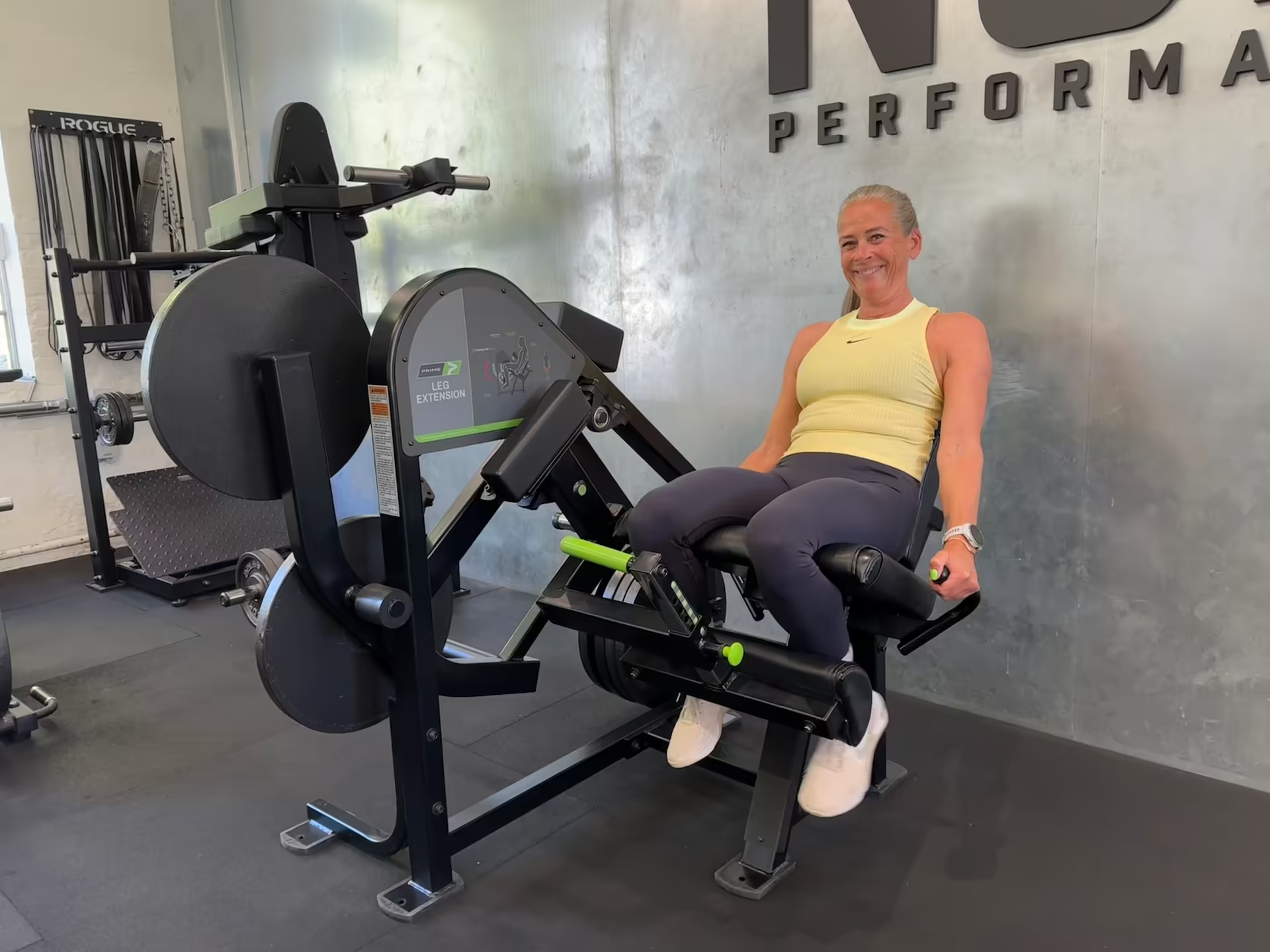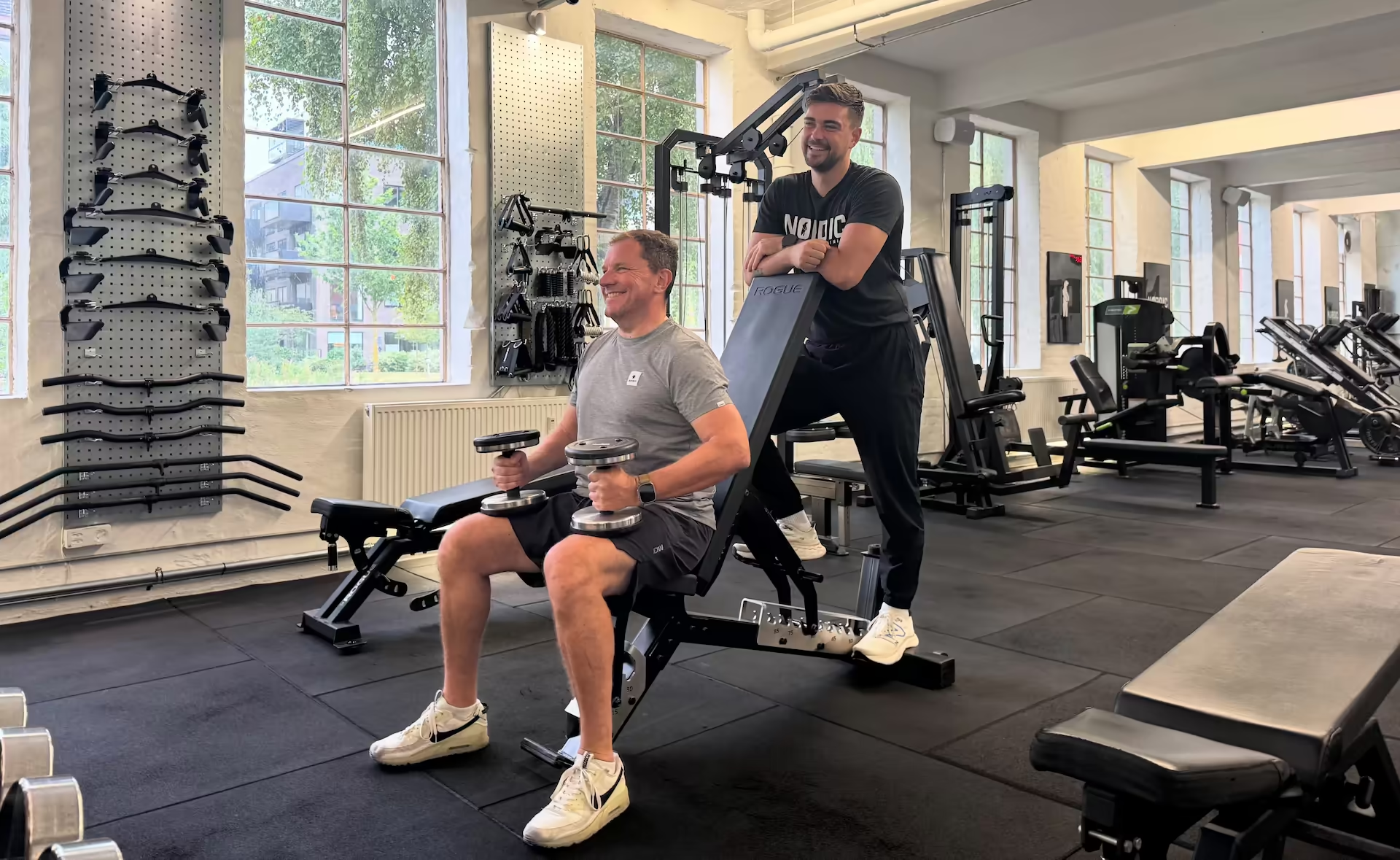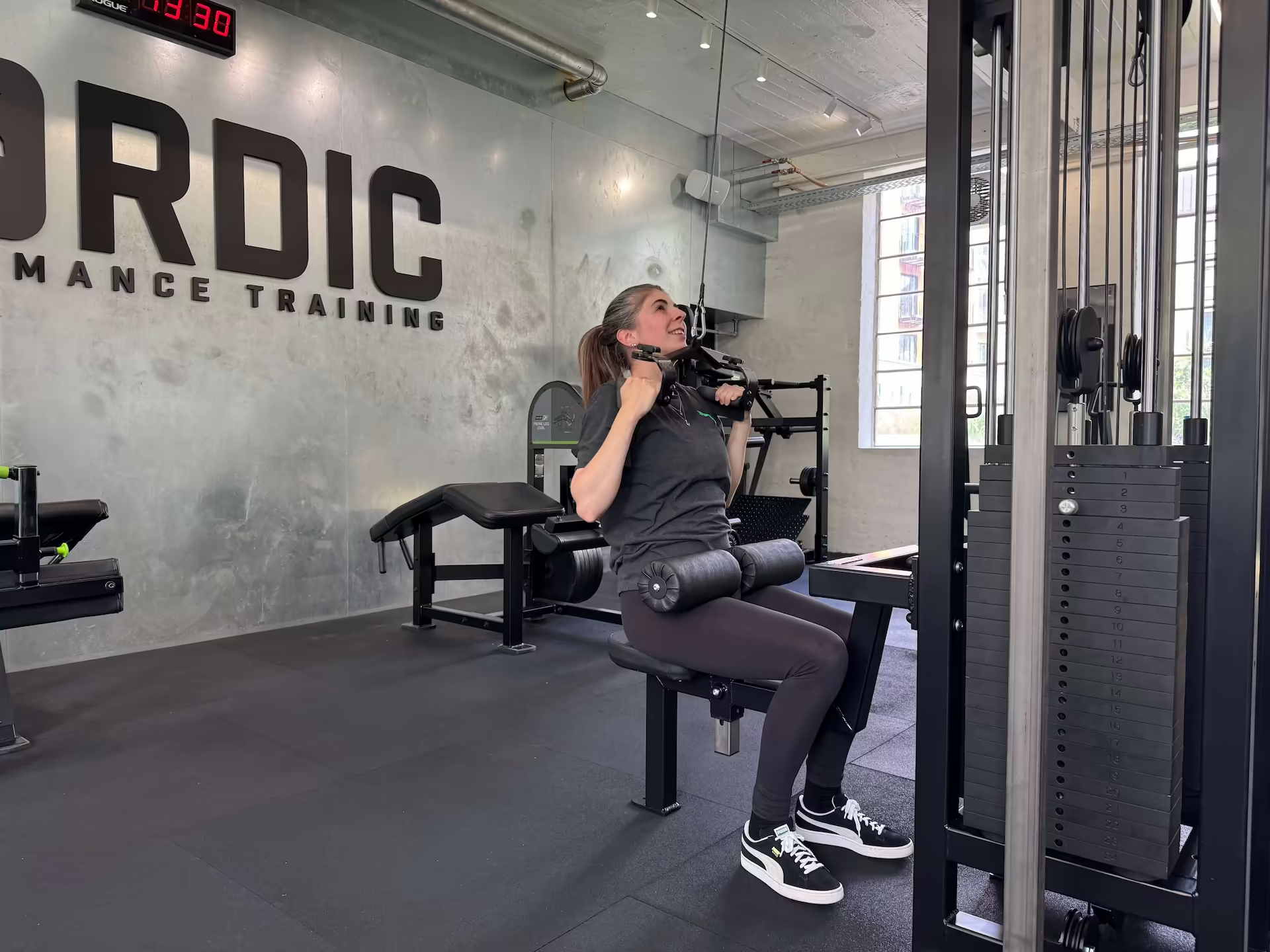60 Isn't Too Late: Breaking the Age Barrier Mindset in Fitness
How our Copenhagen clients over 60 discovered their bodies weren't too old, broken or incompatible with strength training — they were just believing the wrong story about what's possible.
Kirsten walked into a free start-up conversation in our Private Gym in Copenhagen carrying a mental suitcase full of medical notes, "cautious" exercise recommendations, and restrictions she'd collected over many years from healthcare professionals, family members, friends, and colleagues.
At 62, this soon-to-be retired HR professional had been told by various healthcare providers that she needed months of "cautious" bodyweight training—pilates, yoga, aerobics—before attempting any real strength training.
Kirsten's story reflects a cultural barrier we encounter constantly among Copenhagen's 60+ population: the assumption that age automatically equals fragility, and that strength training requires extensive preparation rather than intelligent progression.
"I've been doing balance exercises and resistance band work for several years. Everyone keeps telling me I need to 'build my foundation' first. But I cycle 5 kilometers to work every day and have for 20 years. How much more foundation do I need?" — Kirsten
After working with 3,000+ clients through 50,000+ training sessions in our private Copenhagen gym, we've identified the same pattern repeatedly: the biggest barriers to fitness after 60 aren't physical—they're psychological. Well-meaning healthcare providers, family members, and media messaging have created a narrative that 60+ bodies are inherently fragile. Research and our practical experience prove the opposite.
Here's what we've learned: your body at 60+ isn't broken, too old, or fragile, but your relationship with what you believe it can do might be.
The Well-Meaning Messages That Actually Hold People Back
Copenhagen and Denmark in general have one of the world's most active aging populations. Walk through the city and you'll see 70-year-olds cycling in winter, going for runs at Amager Beach, and maintaining busy social and cultural lives through community activities that would exhaust many 30-year-olds.
Yet somehow, when these same people consider strength training, they accept messages about their limitations that contradict everything else they know about their capabilities.
The advice sounds reasonable on the surface:
- "You need full mobility before lifting weights"
- "Balance training is more important than strength at your age"
- "Start with home exercises for 6 months before going to the gym"
- "Your bones are too weak for heavy loads"
- "You'll struggle to recover from strength training"
Why this language limits progress is explained in Your body is not broken.
The result? Capable people spend months or years doing "preparatory" exercises instead of building the strength that would actually improve their quality of life.
This isn't about dismissing legitimate health considerations. It's about challenging the automatic assumption that age equals fragility when the evidence suggests otherwise.
Case 1: Kirsten's Discovery That "Foundation" Was Holding Her Back
Here's the text formatted correctly:
Kirsten's breakthrough came when we asked a simple question: "If you can cycle 5km daily and climb 3 flights of stairs to your apartment without breathing hard, why do you think you need 6 more months of balance training before doing a seated chest press on a stable machine?"
She stared at me for a moment. "I... honestly don't know. That's just what everyone said I should do."
We started Kirsten with the same systematic approach we use with all clients: full-body strength training with machine-based exercises, focusing on progressive overload within her current capabilities. If you want to learn more about our structured strength training method, read our extensive Full Body guide.
Week 1:
Machine Chest Press: 12.5kg
Cable Pulldown: 30kg
Split Squat: 6kg
Leg Curl: 7.5kg
Month 3:
Machine Chest Press: 17.5kg (+40% from Week 1)
Cable Pulldown: 36kg (+20% from Week 1)
Split Squat: 12kg (+100% from Week 1)
Leg Curl: 12.5kg (+67% from Week 1)
Month 6:
Machine Chest Press: 22.5kg (+80% from Week 1)
Cable Pulldown: 40kg (+33% from Week 1)
Split Squat: 16kg (+166.67% from Week 1)
Leg Curl: 15kg (+100% from Week 1)
"The most shocking thing wasn't getting stronger," Kirsten reflected during her 6-month check-in. "It was realizing I'd wasted years being scared of something my body was perfectly capable of doing from day 1."
Her transformation extended beyond strength gains. Kirsten's confidence in physical activities increased dramatically. She decided to buy a ticket for Royal Run with her daughter, started playing tennis again after a 15-year break, and most importantly, stopped organizing her life around what she couldn't do.
"I spent years preparing to get strong instead of just getting strong. My body was ready—my mind wasn't." — Kirsten
Inspired by Kirsten's return to running? [Your Ultimate Guide to Running a Great 5K – Regardless of Level] shows you how to start safely and progress systematically, just like strength training.
Case 2: Erik's Professional Parallel

Erik, a 65-year-old engineer, applied the same systematic thinking that made him successful professionally to challenge age-related fitness assumptions.
"In my field, we don't abandon projects because materials show some wear," he said. "We engineer solutions that work with existing conditions. Why should my body be any different?"
Erik's engineering background helped him understand progressive overload, systematic progression, and long-term planning. But he'd been influenced by cultural messaging that treated 60+ bodies as problems to manage rather than systems to optimize.
"Everyone talked about 'maintaining' function after 60," Erik explained. "But I maintain bridge infrastructure, and that involves making it stronger, not just preventing collapse."
Erik's systematic approach extended beyond just training. He also prioritized adequate protein intake because the concept of proteins as building blocks resonated with his engineering mindset. "I use quality materials to build stronger structures," he explained. "I needed to make sure my body had all the construction materials it required."
Erik's systematic approach to strength training produced remarkable results:
Erik's 6-month transformation:
Week 1:
- Machine Chest Press: 17.5kg
- Cable Pulldown: 36kg
- Split Squat: 6kg
- Leg Curl: 10kg
Month 3:
- Machine Chest Press: 27.5kg (+57% from Week 1)
- Cable Pulldown: 42kg (+17% from Week 1)
- Split Squat: 16kg (+167% from Week 1)
- Leg Curl: 17.5kg (+75% from Week 1)
Month 6:
- Machine Chest Press: 35kg (+100% from Week 1)
- Cable Pulldown: 48kg (+33% from Week 1)
- Split Squat: 24kg (+300% from Week 1)
- Leg Curl: 20kg (+100% from Week 1)
His professional perspective helped him see through age-related fitness mythology and apply the same systematic improvement mindset he used in engineering. Want to optimize your nutrition for strength building like Erik did? Check out our article Top 5 Muscle Building Nutrition Tips to maximize your efforts in the gym, and our article What Are Supplements? if you want a broader understanding of how different supplements work.
"I stopped trying to 'maintain' my body and started trying to upgrade it. Same principles as any other engineering project." — Erik

Case 3: Marie Was Told She Was Too Fragile for Weight Training
Marie, a 61-year-old retired teacher, came to us with MRI reports, specialist recommendations, and exercise restrictions that painted a picture of a fragile person who needed careful management.
"I have some disc degeneration, a few herniated discs, and a low grade of osteoporosis, and my doctor said I should stick to swimming and walking," she explained. "He told me weight training was too risky at my age with my conditions."
Marie's situation reflects how medical imaging and age-related diagnoses often create psychological fragility that exceeds physical limitations. Her MRI showed changes that are normal for her age, but the messaging focused on pathology rather than capability.
We chose a different path—a path of capability focus, self-empowerment, and optimism that worked with her conditions rather than against them. The key insight: systematic loading often strengthens exactly what diagnostic imagery suggests is "damaged."
Marie's 24-month progression:
Week 1:
- Machine Chest Press: 10kg
- Cable Pulldown: 24kg
- Hack Squat: 10kg
- Leg Curl: 7.5kg
Month 6:
- Machine Chest Press: 17.5kg (+75% from Week 1)
- Cable Pulldown: 32kg (+33% from Week 1)
- Hack Squat: 25kg (+150% from Week 1)
- Leg Curl: 12.5kg (+67% from Week 1)
Month 12:
- Machine Chest Press: 20kg (+100% from Week 1)
- Cable Pulldown: 36kg (+50% from Week 1)
- Hack Squat: 30kg (+200% from Week 1)
- Leg Curl: 15kg (+100% from Week 1)
Month 24:
- Machine Chest Press: 22.5kg (+125% from Week 1)
- Cable Pulldown: 44kg (+83% from Week 1)
- Hack Squat: 35kg (+250% from Week 1)
- Leg Curl: 17.5kg (+133% from Week 1)
"My follow-up scans still show the same abnormalities, with disc degeneration and a few herniated discs, but my osteoporosis has improved significantly at the latest follow-up scan," Marie noted. "And I'm stronger, more confident, and in less daily discomfort than I've been in years. Maybe the scans don't tell the whole story."
Her case illustrates a crucial principle: diagnostic findings don't determine functional capacity. Systematic strength development often improves function despite unchanged imaging results.
"I learned the difference between having something on a scan and being disabled by it. Strength training helped me work with my body instead of being afraid of it." — Marie
Case 4: Lars and the "Too Late" Myth
Lars, a 68-year-old former bank executive, had accepted a different narrative: that serious fitness was a young person's game, and his window had closed.
"I was never athletic," he told us during his consultation. "I worked 60-hour weeks for 30 years, never set foot in a gym. At my age, isn't it just too late to start?"
Lars represented a common mindset: that fitness requires a lifelong foundation, and starting after 60 means settling for maintenance rather than improvement.
His limiting beliefs were reinforced by well-meaning family members who worried about him "overdoing it" and fitness content that focused on "age-appropriate" movements rather than simple, structured progressive strength development.
We started Lars with the same systematic approach as any other client, adjusting load but not philosophy.
The results over 12 months:
- Hack Squat: 10kg → 40kg (300% increase)
- Machine Chest Press: 15kg → 40kg (167% increase)
- Cable Pulldown: 30kg → 55kg (83% increase)
- Leg Curl: 10kg → 25kg (150% increase)
- Leg Extension: 12.5kg → 30kg (140% increase)
But the physical changes were secondary to the psychological shift. Lars stopped seeing himself as someone whose "physical prime" was far behind him and started seeing himself as someone actively building strength.
"At 68, I'm stronger than I was at 40," Lars said during a recent session. "I wish I'd started sooner, but I'm grateful I didn't wait any longer."
The "too late" narrative had kept Lars weak for decades. The systematic strength training proved it was false.
"I thought I was too old to get strong. Turns out I was just young enough to believe that was true." — Lars

How Danish Culture Supports Active Aging
Danish culture naturally supports staying active after 60 in ways that benefit our clients:
Daily Cycling: Most of our clients over 60 bike regularly, proving to themselves every day that they're capable of sustained physical effort. This builds confidence that contradicts "be careful" messaging.
Long-term Thinking: Danish culture values sustainable approaches over quick fixes. The same patient, consistent mindset that builds careers also builds physical strength.
Simple Solutions: Danes prefer things that work reliably over things that look impressive. This applies perfectly to strength training—simple, consistent progress beats complicated routines.
Active Expectations: In Copenhagen, 70-year-olds cycle to dinner and stay involved in community activities. Being 60+ doesn't automatically mean slowing down here.
How Your Mind Creates Age-Related Barriers
Understanding why intelligent, capable people accept age-related limitations requires looking at how our minds respond to cultural messaging about aging.
When someone repeatedly hears "be careful at your age" or "you need to do everything differently now," their brain treats this as warning information. The nervous system becomes cautious, limiting strength and coordination even when physical capacity exists.
This creates a self-fulfilling prophecy: expecting fragility leads to moving like you're fragile, which leads to actual weakness over time.
Our systematic strength training approach works because it provides proof that contradicts these limiting beliefs. When Kirsten chest presses 22.5kg or Lars hack squats 40kg, their nervous system gets undeniable evidence that their assumptions about their limitations were wrong.
Each successful session literally changes expectations about what's possible.
A Simple Approach to Getting Stronger After 60
Based on our work with hundreds of clients over 60, here's what consistently works:
Focus on What Works, Not What's Wrong Instead of listing everything that might be "broken," look at what's already working. Can you walk upstairs? Carry groceries? Get up from a chair? You have more capability than you think.
Use the Same Methods, Just Adjust the Starting Point The same principles that make younger people stronger work for people over 60. Start lighter, but follow the same systematic approach.
Getting Stronger Prevents Injuries When your muscles, bones, and joints get systematically stronger, they become more resilient, not more fragile. Strength training is injury prevention.
Track Numbers, Not Just How You Feel Write down the weights you lift and exercises you complete. Feelings can be influenced by what others tell you; numbers show what's actually happening.
See Yourself as Someone Getting Stronger Instead of "I'm 64 with limitations," try "I'm someone building strength." How you see yourself affects how you act.
If you’re considering starting out with a personal trainer, you can find practical tips, key questions to ask, and common red flags to avoid in our article How to Choose Your Personal Trainer in Copenhagen.
What Research Shows About Getting Stronger After 60
Research consistently shows that strength training works at any age. Many studies reveal that people over 60 can still build muscle, strengthen bones, and improve coordination when they train in a structured, systematic, and consistent way.
Three Key Findings That Change Everything
Your muscles still respond:
Research shows that older adults can build muscle almost as effectively as younger people when they train consistently and consume adequate protein. It might require a little more effort, but meaningful gains are absolutely possible.
Your bones get stronger:
Numerous studies demonstrate that progressive strength training increases bone density in older adults, significantly reducing the risk of fractures.
Your nervous system adapts:
Strength training improves coordination, balance, and motor control by stimulating neurological adaptation. These improvements are crucial for maintaining independence and reducing fall risk.
The real question isn’t whether people over 60 can get stronger through training — it’s whether they can start seeing themselves as people who get stronger, not just people who try to avoid getting weaker.
“The real question isn’t whether 60+ bodies can adapt… it’s whether 60+ minds can.”
Why This Mindset Shift Changes Everything
The clients featured in these case studies didn't just get stronger. They fundamentally changed their relationship with their aging bodies and expanded their sense of what's possible in their 60s, 70s, and beyond.
Kirsten started playing tennis again. Lars felt stronger than he was in his 40s. Marie stopped being afraid of physical challenges. Erik approached his retirement with excitement about what he could build rather than anxiety about what he might lose.
The strength gains were measurable, but the mindset shift was transformational.
When you stop organizing your life around what you can't do and start systematically building what you can do, everything changes.
Frequently Asked Questions About Fitness Around 60
Is 60 too late to build muscle?
No. Older adults can increase muscle size and strength with consistent, progressive resistance training and adequate protein. The key is starting at an appropriate load and progressing week by week.
How often should I strength train after 60?
1-3 Full Body strength training sessions per week works best for most people. This frequency balances recovery with enough practice on key movements to drive steady gains in strength, balance, and confidence.
Is strength training safe with osteoporosis or disc degeneration?
Yes, when it’s supervised and progressed intelligently. Machine-based and controlled free-weight exercises with gradual loading improve bone density, muscle support, and function without relying on painful ranges.
Do I need perfect mobility and balance before lifting weights?
No. Strength training itself improves mobility and balance when loads are progressed gradually. Start with stable, machine-based movements and add balance challenges later as strength and confidence grow.
How heavy should I lift at 60+?
Begin with loads you can control for 6–8 reps with 2–4 reps “left in the tank.” Increase the weight slightly once you hit your top rep target with good form across all sets to ensure safe, measurable progress.
Ready to Challenge What You've Been Told About Age and Strength?

If you're over 60 and have been told you need months of "preparation" before real strength training, or that your window for significant improvement has closed, the evidence suggests otherwise.
Your body isn't automatically fragile because of a number. Your capacity for strength development doesn't disappear at 60. The biggest barrier to building strength after 60 isn't physical—it's the story you've been told about what's possible.
"Age is just the amount of time you've been alive. It doesn't determine what you're capable of building from this point forward." — Our core philosophy
After working with hundreds of clients over 60 through systematic strength training, we've seen repeatedly that the biggest transformations happen when people stop trying to work around their age and start working with their actual capabilities.
Your body isn't broken because you're 60+. It's ready for the right challenge, with the right progression, guided by the right mindset.
If you're ready to discover what systematic strength development can do for your capabilities, confidence, and quality of life, we'd love to help you design an approach that works with your body as it is today while building toward what it can become.
At our private gym in Copenhagen, we specialize in systematic strength development for people who've been told they need to "be careful" but are ready to be capable instead. Our evidence-based approach has helped hundreds of clients over 60 discover that their assumptions about age-related limitations were more limiting than their actual age.
Book a free start-up conversation and discover what's possible when you stop preparing to get strong and start systematically building strength. No obligation—just a conversation about what capability-focused strength development looks like for someone who's ready to challenge what they've been told about aging.
Because the best time to start building strength was 20 years ago. The second best time is today.
References
Aagaard, P. et al. (2010). Role of the nervous system in sarcopenia and muscle atrophy with aging: Strength training as a countermeasure. Scandinavian Journal of Medicine & Science in Sports, 20(1), 49–64. https://pubmed.ncbi.nlm.nih.gov/20487503/
Brinjikji, W., Luetmer, P. H., Comstock, B., Bresnahan, B. W., Chen, L. E., Deyo, R. A., Halabi, S., Turner, J. A., Avins, A. L., James, K., Wald, J. T., Kallmes, D. F., & Jarvik, J. G. (2015). Systematic literature review of imaging features of spinal degeneration in asymptomatic populations. American Journal of Neuroradiology, 36(4), 811–816. https://doi.org/10.3174/ajnr.A4173
Chambers, T. L. et al. (2024). Lower extremity muscle hypertrophy in response to resistance training in older adults: Systematic review, meta-analysis, and meta-regression of randomized controlled trials. Clinical Nutrition, 43(9), 1390–1400. https://pubmed.ncbi.nlm.nih.gov/39579806/
Fragala, M. S. et al. (2019). Resistance training for older adults: Position statement from the National Strength and Conditioning Association. Journal of Strength and Conditioning Research, 33(8), 2019–2052. https://pubmed.ncbi.nlm.nih.gov/31343601/
Liu, C. J., & Latham, N. K. (2009). Progressive resistance strength training for improving physical function in older adults. Cochrane Database of Systematic Reviews, (3), CD002759. https://pubmed.ncbi.nlm.nih.gov/19588334/
Segerstrom, S. C., & Sephton, S. E. (2010). Optimistic expectancies and cell-mediated immunity: The role of positive affect. Psychological Science, 21(3), 448–455. https://doi.org/10.1177/0956797610362061
Vlaeyen, J. W. S., & Linton, S. J. (2000). Fear-avoidance and its consequences in chronic musculoskeletal pain: A state of the art. Pain, 85(3), 317–332. https://doi.org/10.1016/S0304-3959(99)00242-0
Watson, S. L. et al. (2015). High-intensity resistance and impact training improves bone mineral density and physical function in postmenopausal women with osteopenia and osteoporosis: The LIFTMOR randomized controlled trial. Journal of Bone and Mineral Research, 30(10), 1810–1818. https://pubmed.ncbi.nlm.nih.gov/28975661/
Related Blog Posts
.svg)
.svg)

.svg.webp)












